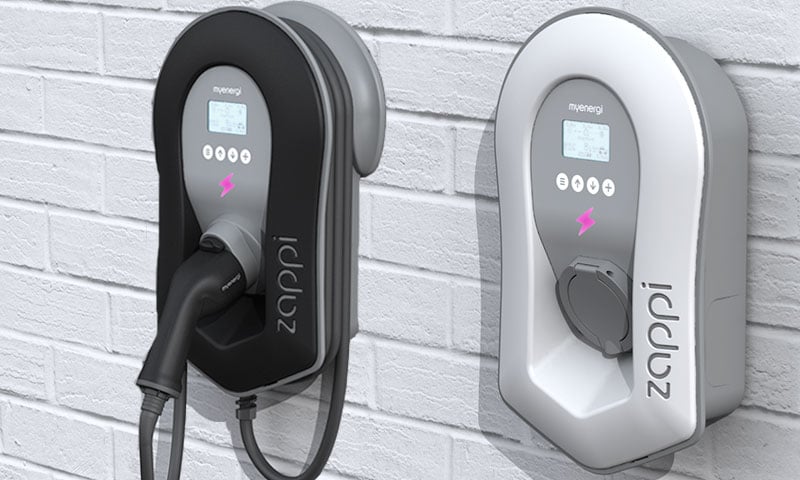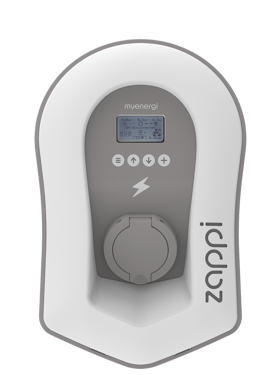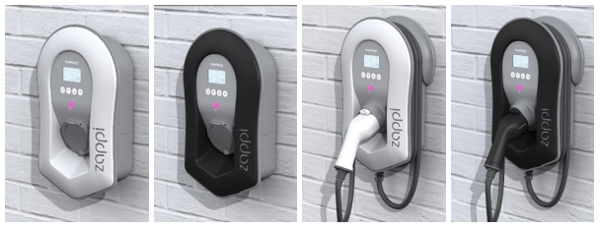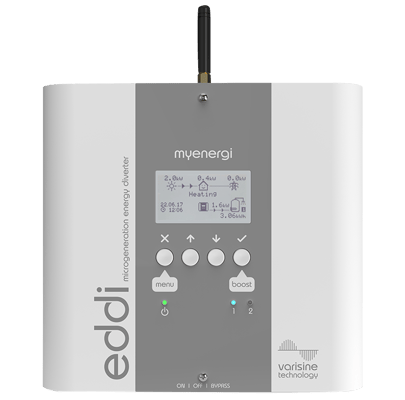

Many of our customers have installed an immersion optimiser to divert excess solar PV into their hot water tank.
If you have an electric vehicle (EV), it makes sense to divert excess electricity into the EV battery. In fact if your hot water is heated by gas, oil or biomass, it makes more sense to charge the car than it does to charge the hot water tank. An iBoost is generally displacing fuel costing ~ 5.82p per kWh, and so 1kWh of diverted electricity is worth ~ 5.82p. Charging the EV displaces grid electricity at the ‘full value’ ~ 22.36p per kWh.

zappi is an EV charging point with special eco charging modes to optimise self-consumption of on-site solar PV, wind etc. Specifically it has three charging modes:
With the Min Green Level set to 10%, charging will be paused if more than 1260W of power is being imported from the grid, and will resume as soon as 140W or more is being exported from solar.
By setting the Min Green Level to 100%, the car will be charged using only surplus renewable power, providing there is sufficient surplus power to do so.
Note: The EV charging standard does not support charging below 1.4kW.
To supplement the ECO and ECO+ modes, there are various optional boost functions, designed to ensure your car achieves minimum levels of charge whatever the weather. More on these below.
The zappi charger is available in either a 7kW single phase or 22kW 3-phase version. You can choose either of these with a tethered Type 2 6.5m cable or untethered, and in a white or black finish.

The single phase 7kW version is suitable for most domestic installations, while the 3-phase is ideal for commercial properties where this electricity supply is available.
It’s worth noting that the myenergi zappi charger complies with the BS7671 18th Edition regulations which came into force in January 2019. Currently it is the only available chargepoint that doesn’t require an earth rod for most installs, which gives rise to a significant installation cost saving relative to other chargepoints.
The average cost of a second generation zappi installed is around £1,395 (including VAT), depending on cabling requirements.
The eddi is similar to an iBoost or Immersun, in that it diverts excess solar generation to the hot water tank. If you install zappi and eddi, you can choose whether to prioritise zappi or eddi.

If you have a zappi or eddi, you can remotely control and monitor these devices with inbuilt wifi or ethernet connections. This means you can track your usage of surplus energy going into car charging or heating.
zappi responds quicker than the immersion optimiser, and so the default will be that zappi will be switched on before the optimiser. If you don’t want this to happen, you can set a delay on the zappi to give the optimiser time to turn on.
If you have a DC coupled battery system, the battery will always take priority over the zappi. If you have an AC coupled system (e.g. Tesla Powerwall 2), the battery system is likely to have a similar response time to zappi. Therefore you need to set a delay on the zappi if you want to prioritise charging of your battery over your zappi. If you want to prioritise the zappi over the battery there is a workaround we can install using a CT clamp – this will tell the zappi when the battery is being charged, thus turning on the zappi, subject to sufficient power availability.
To supplement the ECO and ECO+ modes, there are various optional boost functions, designed to ensure your car achieves minimum levels of charge whatever the weather.
The zappi’s a great product with all bases covered – just what you need if you drive an EV and you want to optimise the use of your solar.
Learn more about home charging with our free guide:
Copyright © Spirit Energy 2026 · info@spiritenergy.co.uk · 0118 951 4490
Jobs and Careers
Interested in joining the Spirit team? Email jobs@spiritenergy.co.uk
Spirit House, 25 Albury Close, Reading, RG30 1BD
(Location formerly known as 44 Portman Road, Reading, RG30 1EA)
Spirit Energy is the trading name of Spirit Solar Ltd · UK Company Number 07138647
Although care is taken to ensure that the information on our website (www.spiritenergy.co.uk) and any guides, calculators or checklists provided by us, electronically or otherwise, are accurate and up-to-date, we cannot accept any responsibility for mistakes or omissions. We enter into no express or implied conditions, warranties, terms or representations regarding the quality, accuracy or completeness of the information. We exclude to the extent lawfully permitted all liability for loss or damage, whether direct, indirect or consequential arising out of your use of our website or any guides, calculators or checklists provided by us, or from any information or omission contained in our website or any guides, calculators or checklists provided by us.